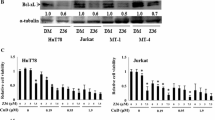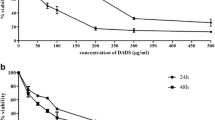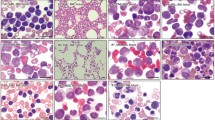Abstract
Armillaridin (AM) is an aromatic ester compound isolated from Armillaria mellea. Treatment with AM markedly reduced the viability of human chronic myelogenous leukemia K562, chronic erythroleukemia HEL 92.1.7, and acute monoblastic leukemia U937 cells, but not normal human monocytes, in a dose- and time-dependent manner. Treatment of K562 cells with AM caused changes characteristic of autophagy. Only a small amount of AM-treated K562 cells exhibited apoptosis. By contrast, AM treatment resulted in extensive apoptotic features in U937 and HEL 92.1.7 cells without evident autophagy. The autophagy of K562 cells induced by AM involved autophagic flux, including autophagosome induction, the processing of autophagosome-lysosome fusion and downregulation of BCL2/adenovirus E1B 19 kDa interacting protein 3 (BNIP3). By bcr-abl knockdown, the growth inhibition of K562 cells caused by AM was partially blocked, suggesting that AM-induced cell death might be a bcr-abl-dependent mode of autophagy-associated cell death. In conclusion, AM is capable of inhibiting growth and inducing autophagy-associated cell death in K562 cells, but not in normal monocytes. It may have potential to be developed as a novel therapeutic agent against leukemia.









Similar content being viewed by others
Abbreviations
- AM:
-
Armillaridin
- BNIP3:
-
BCL2/adenovirus E1B 19 kDa interacting protein 3
- CML:
-
Chronic myelogenous leukemia
- CQ:
-
Chloroquine
- 3-MA:
-
3-Methyladenine
- STI-571:
-
Signal transduction inhibitor-571
References
Hehlmann R, Hochhaus A, Baccarani M, European L. Chronic myeloid leukaemia. Lancet. 2007;370:342–50.
Apperley JF. Chronic myeloid leukaemia. Lancet. 2014.
Bellodi C, Lidonnici MR, Hamilton A, Helgason GV, Soliera AR, Ronchetti M, Galavotti S, Young KW, Selmi T, Yacobi R, Van Etten RA, Donato N, Hunter A, Dinsdale D, Tirro E, Vigneri P, Nicotera P, Dyer MJ, Holyoake T, Salomoni P, Calabretta B. Targeting autophagy potentiates tyrosine kinase inhibitor-induced cell death in Philadelphia chromosome-positive cells, including primary CML stem cells. J Clin Invest. 2009;119:1109–23.
Lung MY, Chang YC. Antioxidant properties of the edible Basidiomycete Armillaria mellea in submerged cultures. Int J Mol Sci. 2011;12:6367–84.
Yang JS, Chen YW, Feng XZ, Yu DQ, Liang XT. Chemical constituents of Armillaria mellea mycelium. I. Isolation and characterization of armillarin and armillaridin. Planta Med. 1984;50:288–90.
Chi CW, Chen CC, Chen YJ. Therapeutic and radiosensitizing effects of armillaridin on human esophageal cancer cells. Evidence-based complementary and alternative medicine: eCAM. 2013;2013:459271.
Glick D, Barth S, Macleod KF. Autophagy: cellular and molecular mechanisms. J Pathol. 2010;221:3–12.
Marino G, Niso-Santano M, Baehrecke EH, Kroemer G. Self-consumption: the interplay of autophagy and apoptosis. Nat Rev Mol Cell Biol. 2014;15:81–94.
Strober W. Trypan blue exclusion test of cell viability. Current protocols in immunology/edited by John E Coligan [et al]. 2001;Appendix 3:Appendix 3B.
Puissant A, Grosso S, Jacquel A, Belhacene N, Colosetti P, Cassuto JP, Auberger P. Imatinib mesylate-resistant human chronic myelogenous leukemia cell lines exhibit high sensitivity to the phytoalexin resveratrol. FASEB J. 2008;22:1894–904.
Sen N, Das BB, Ganguly A, Mukherjee T, Tripathi G, Bandyopadhyay S, Rakshit S, Sen T, Majumder HK. Camptothecin induced mitochondrial dysfunction leading to programmed cell death in unicellular hemoflagellate Leishmania donovani. Cell Death Differ. 2004;11:924–36.
Huang HL, Chen YC, Huang YC, Yang KC, Pan H, Shih SP, Chen YJ. Lapatinib induces autophagy, apoptosis and megakaryocytic differentiation in chronic myelogenous leukemia K562 cells. PLoS One. 2011;6:e29014.
Schneider CA, Rasband WS, Eliceiri KW. NIH image to ImageJ: 25 years of image analysis. Nat Methods. 2012;9:671–5.
Jacquel A, Herrant M, Legros L, Belhacene N, Luciano F, Pages G, Hofman P, Auberger P. Imatinib induces mitochondria-dependent apoptosis of the Bcr-Abl-positive K562 cell line and its differentiation toward the erythroid lineage. FASEB J. 2003;17:2160–2.
Azad MB, Gibson SB. Role of BNIP3 in proliferation and hypoxia-induced autophagy: implications for personalized cancer therapies. Ann N Y Acad Sci. 2010;1210:8–16.
He C, Klionsky DJ. Regulation mechanisms and signaling pathways of autophagy. Annu Rev Genet. 2009;43:67–93.
Daido S, Kanzawa T, Yamamoto A, Takeuchi H, Kondo Y, Kondo S. Pivotal role of the cell death factor BNIP3 in ceramide-induced autophagic cell death in malignant glioma cells. Cancer Res. 2004;64:4286–93.
Chen YJ, Huang WP, Yang YC, Lin CP, Chen SH, Hsu ML, Tseng YJ, Shieh HR, Chen YY, Lee JJ. Platonin induces autophagy-associated cell death in human leukemia cells. Autophagy. 2009;5:173–83.
Kanzawa T, Zhang L, Xiao L, Germano IM, Kondo Y, Kondo S. Arsenic trioxide induces autophagic cell death in malignant glioma cells by upregulation of mitochondrial cell death protein bnip3. Oncogene. 2005;24:980–91.
Cheng Y, Qiu F, Huang J, Tashiro S, Onodera S, Ikejima T. Apoptosis-suppressing and autophagy-promoting effects of calpain on oridonin-induced L929 cell death. Arch Biochem Biophys. 2008;475:148–55.
Goussetis DJ, Gounaris E, EJ W, Vakana E, Sharma B, Bogyo M, Altman JK, Platanias LC. Autophagic degradation of the BCR-ABL oncoprotein and generation of antileukemic responses by arsenic trioxide. Blood. 2012;120:3555–62.
Sheng Z, Ma L, Sun JE, Zhu LJ, Green MR. BCR-ABL suppresses autophagy through ATF5-mediated regulation of mTOR transcription. Blood. 2011;118:2840–8.
Acknowledgments
We want to thank Dr. King-Song Jeng and the National RNAi Core Facility, Academia Sinica, Taiwan, for shRNA knockdown techniques, the pTRC-905 vector, and the pTRC-905-shBCR constructions. This work was supported by grant NSC98-2323-B-241 from the National Science Council, Taiwan, and grant 09MMHIS027 and MMH-E-105-13, E-104-13 from MacKay Memorial Hospital, Taiwan.
Author information
Authors and Affiliations
Corresponding authors
Ethics declarations
Conflicts of interest
None.
Electronic supplementary material
Supplemental Figure 1.
Effect of armillaridin on BCR-ABL expression on K562 cells. Cells were untreated, treated with 0.1% DMSO (solvent), 10 μM armillaridin for 24 hours or starvation for 6 hours. Protein extracts from whole cells were subjected to Western blotting. Data from three separate experiments showed similar trend. No significant differences on the expression of BCR-ABL were found between control and armillaridin treatment. (GIF 175 kb)
Rights and permissions
About this article
Cite this article
Chang, WH., Huang, HL., Huang, WP. et al. Armillaridin induces autophagy-associated cell death in human chronic myelogenous leukemia K562 cells. Tumor Biol. 37, 14291–14300 (2016). https://doi.org/10.1007/s13277-016-5208-6
Received:
Accepted:
Published:
Issue Date:
DOI: https://doi.org/10.1007/s13277-016-5208-6




